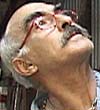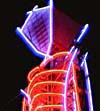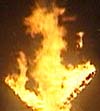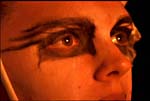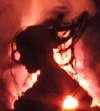Dream
Sequence 8
Phase four: Shooting begins
My first video of the Temple of Rudra project was shot in Pepe's big sculpture studio near Candlestick Park in San Francisco. I spent a few days rushing around him as he welded his insect gods and talked about the opera. Pepe has a husky voice with a heavy Argentinean accent, and even with my shotgun mic I always tried to get up close to him while he spoke, to keep his voice as clear as possible. This wasn't easy with an arc welder periodically showering me with sparks. But a lot of the mythology behind the opera is revealed by Pepe in this scene, saving me from having to tell much of it in a voice-over. The overcast daylight coming through the big skylights into his studio is beautiful in these shots.
What followed was a lot of meetings. Meetings with Pepe and various sect leaders. Meetings of sect leaders and sect members. Costume meetings, set meetings, rehearsals. I was just shooting hours of footage that I really didn't know how I was going to edit together at the time. I was, of course, trying to do two things at once: tell the story of the opera itself coming together, while at the same time reveal some of this unique strata of San Francisco "chaos culture" in the process. It was impossible to know when something useful was going to come up. The more I shot, the more I knew that I would be spending many months in the editing suite, trying to strike the balance I wanted.
Although these meetings were small, seldom more than 20 people, they were each a unique challenge to document. Much of the time the meetings were held in darkened rooms (which contributed to the mysterious, cultish atmosphere, but were hell to shoot). Any one of a few new cameras (Canon GL1, Sony PD100A) would have helped out in this regard, but I managed to capture it passably with the VX1000. Interesting visuals and sound bites would happen suddenly, with little warning, so the camera just rolled along. Often, I wanted to shoot someone listening or reacting while another person spoke. To do this, I often employed a loosely mounted "L" shaped handgrip (available at most consumer electronics stores for about $20). I would mount the shotgun mic on the accessory shoe of the handgrip and swivel it in the direction of the speaker while shooting the listener on the other side of the room. This often made for a more interesting shot than a straight-on talking head. It was especially important for this part of the documentary, which included a lot of talking.
Another tool I considered using was a pro/consumer audio adapter, like the ones made by BeachTek that sell for about $250. These are small, level-controllable units that are mounted to the tripod hole of a camera, plug into its mini microphone jack and can take two professional XLR connectors from pro mics, routing the signals to separate discrete stereo channels. By using this type of adapter, I could have set up a mic pointed in one direction on a stand (or held by an assistant) and kept another mounted on the camera. But my primary concern was always quick mobility. Had my shooting style been less active, I might have changed my approach.
I developed a style early on in the shooting that I decided to stay with. I would shoot close up on everything I could, as often as possible. My technique would be to actually move myself and my camera right up to the subject, with the camera zoomed out wide, and just hold the shot. There are very few "big" shots, zooms, and pans in the movie. These are the things that film cameras with great lenses can do successfully, but a small video camera with a fixed lens simply cannot. Knowing the limits of the tools I was working with enabled me to use them to their best storytelling advantage, minimizing the kinds of shots that make people want to tune out.
After months of meetings, myth/script clarification, and costume development, it was time for something like a dress rehearsal. The opportunity came when the city of San Francisco decided to host a formal recognition of Burning Man by hosting a Burning Man art show and a huge downtown event. The mayor and other luminaries were in attendance, and an amazing procession lit up the streets of San Francisco that night featuring a giant burning chalice, which moved down Van Ness Avenue in front of City Hall and the opera house. Shooting this strange parade was an extremely active exercise - running ahead of the action, planting myself in a good spot and letting the procession pass. It culminated in an incredible performance of arcane rituals, mad drumming, fire dancers, and belly dancers at the foot of the 40-foot-high Burning Man effigy, which had been set up in a vacant lot next to the San Francisco Arts Commission Gallery. Not something you'll soon see at Disneyland.
Next >>
|
